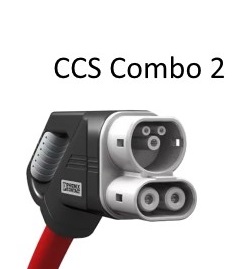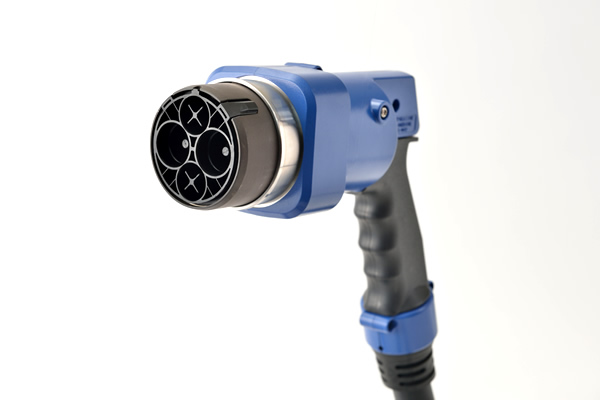
Electric Vehicle Supply Equipment (EVSE) is the hardware that supplies electrical energy to charge an EV battery. The electricity grid delivers AC (alternating current) but EVs charge their batteries with DC (direct current). An electric vehicle has an onboard charger to convert AC power to DC.
The difference between AC and DC charging
An EV charger can either supply AC or DC power.
When an EV uses an AC power supply for charging, it must convert the power supply from AC to DC via its on-board charger. The onboard charger defines and limits how fast the vehicle can be charged. Most EVs on the market today are capable of accepting only 7kW AC, even when connected to a 22kW charger, because the onboard charger limits the utilisation of the charger and power supply.
Alternatively, when an EV uses a DC power supply for charging, the charger converts the AC power to DC and therefore the current can bypass the onboard charger and deliver the power supply directly to the battery. This occurs at a much higher rate and via a special cable. Most EVs on the market today are capable of accepting 100 kW, with the market leaders capable of 250 kW.
Compared to AC chargers, DC chargers are more complex in design and cost. In order to deliver the high power required for fast charging, they demand heavy duty electrical systems and grid connections, meaning upgrades to the electrical infrastructure at the site might be necessary.

How power is delivered to an EV
The level of charger refers to the amount of power delivered to a vehicle, where level one is the lowest and level three is the highest.
| Level | Type | Where | kW (up to) | Time to add 100km of range* |
|---|---|---|---|---|
| Level 1 | Type 1: Household power point and adaptor | Anywhere there is a normal power point | 2.3 kW | 8.7 hrs |
| Level 2 | Type 2: Wall charger | Homes, hotels, workplaces | 7.4 kW | 2.7 hrs |
| Type 2: Wall charger | Shopping centres, public car parks, on-street parking | 22 kW | 55 mins | |
| Level 3 | Type 3: Fast charger | Intercity travel, petrol stations | 50 kW | 24 mins |
| Type 3: Fast charger | Faster capacity charging for intercity travel and petrol stations | 120 kW | 10 mins | |
| Ultra-rapid charger | Highways and long-distance travel routes | 350kW | 10 mins |
*based on a vehicle energy efficiency of 20 kWh/100 km
Connector types and Australian standards
For both AC and DC charging, there are a number of different connectors and plugs in use across the world.
The Federal Chamber of Automotive Industries (FCAI) endorses the Type 2 (Mennekes) plug for AC charging and both the CCS and ChaDeMo for DC charging.
This means that an electric vehicle with a Type 2 plug will also require a CHAdeMO plug to charge using AC and DC power. However, an EV with a CCS plug will be able to charge AC and DC using the same plug.
The specifications are outlined below:
| Plug | Power Delivery and Features | Picture |
|---|---|---|
| Type 2 (Mennekes) | Level 1 and Level 2 AC Vehicle-charger communications Single-phase charging up to 14.5 kW Three-phase charging up to 43.5 kW Compatible with CCS vehicle socket Theft-proof locking pin |  |
| Combined Charging System (CCS) | Level 3 DC Deliver high power, over 50 kW Uses Power Line Communication (PLC) the standard grid communication system |  |
| Charge de Move (CHAdeMO) | Level 3 DC Deliver high power, over 50 kW Uses CAN (Controller Area Network) the standard in-vehicle communication protocol |  |
Ergonomic considerations when using chargers
Charging equipment can be specified to best suit the site.
Type of site:
-
- Indoor/outdoor – Outdoor chargers must meet design standards for weather proofing and impact damage
- Tethered/Untethered – Tethered chargers have a permanently fixed charging cable/connector. They are more convenient for drivers but are vulnerable to vandalism and may present a trip hazard
- Mount – Chargers must be positioned at a convenient height and can be wall or pedestal mounted. Chargers require electrical supply via ceiling or subterranean conduits. Subterranean conduits may require expensive trenching/tunnelling, particularly for retrofits.
Key evaluation criteria when evaluating chargers
Should a charger be stand-alone or connected to a network?
Chargers that are equipped with a modem or WIFI/ethernet connection can be networked. A networked charger can be remotely operated by the host or a 3rd party service provider, enabling the following functionality:
- See charger status (in use/available)
- Monitor charger performance
- Update firmware.
How can you control who uses the charger?
An operator can limit the use of charger to staff or members by implementing an authentication system. These systems can also be used to track who is using the charger, with the ability to create profiles of each driver. There are a couple of ways of doing this:
- An RFID equipped charger can be activated with a staff or membership card.
- Networked chargers can be activated via the cloud. The driver simply plugs in and initiates the session on their phone app.
How to manage multiple chargers on one site
Multiple chargers on one site will draw a lot of power if used at the same time. Without a management system, this may require an increase to the site power capacity, increasing the fixed cost of electricity. A charge management system can be set up to minimise this impact by:
- Setting a limit to the system power draw
- Allocating charge sessions for connected vehicles
- Prioritising fast charging for vehicles with low state-of-charge
Read about charger installation process and costs.

